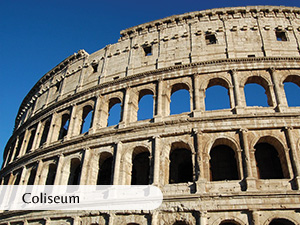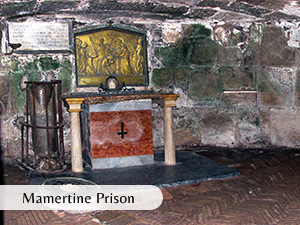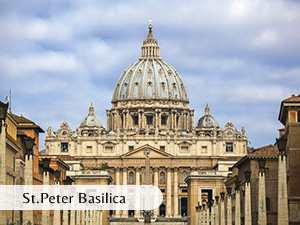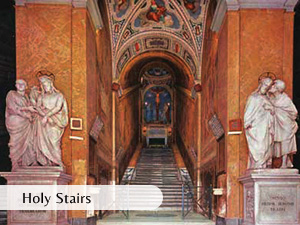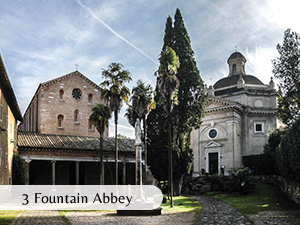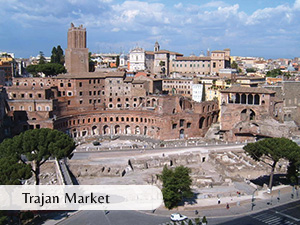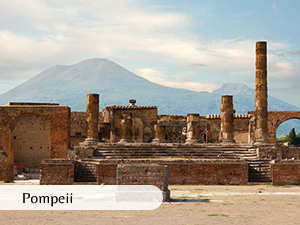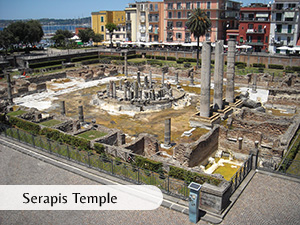
Catholic Tour in Italy / Biblical Rome & Naples
A 6 Days / 5 Nights Catholic Tour In Italy
Itinerary
DAY 1: Rome
Meet and greet at the Airport with our tour escort and transfer to the hotel for check in. After that meet the guide for an orientation tour of Rome including the Mamertine prison (site that records the tradition to be the place where Saint Peter and Saint Paul were imprisoned) and St. Peter in Chains (named for the chains that held St. Peter when he was imprisoned in Rome and in Jerusalem. The church is however best known for the statue of Moses that Michelangelo created for the tomb of pope Julius II). Dinner and overnight at the hotel or nearby.
DAY 2: Rome
Breakfast and visit to the Vatican City (length 4hrs approx.). If the tour dates include a Wednesday in Rome, we can escort the group to St Peter's Basilica for the Papal Audience in the morning and at the end of the Papal blessing, guided tour of the Vatican Museum. Our Tour-guide will lead you through the treasures preserved at the museums visiting also the Sistine Chapel with the masterpieces of Michelangelo, including the Last Judgement, and St. Peter Basilica. Transfer back to the hotel. Dinner and overnight at the hotel or nearby.
DAY 3: Rome
After breakfast meet the guide at hotel and start the Christian tour with Basilicas of Rome and the Catacomb (length 4hrs approx.). The history of these Basilicas comes together the history of Rome, scaring the religious path, the social events and the artistic experience: The Cathedral of Rome and the most ancient Basilica of the western world; St John's Lateran Basilica. It has been funded by Constantine I as the main church of Rome and subsequently converted to the Baroque style by Francesco Borromini. All Popes have been crowned here until 19th century and nowadays it's the official seat of the Roman Bishop. The large complex around the Church embraces the Lateran Palace, the Major Pontifical Roman Seminary and the Pontifical Lateran University. Stop to visit the Holy Stair on the left side of the Square. The Stair that, according to the Christian tradition, was climbed by Jesus to reach the room of the Interrogation with Pontius Pilate before the crucifixion. The 28 steps have been put into effect starting from the highest one, to avoid the builders walk on them and allow only the Pilgrims to kneel down on the stair. Proceed to St Paul Outside the Walls Basilica, rising on the legendary burial place of St Paul Apostle, in the middle of an ancient guest-house on the long way to Ostia.
The Basilica, rebuilt after the fire on 1823, is the second largest Church after St Peter at the Vatican. Here, under the major altar, there's the tomb of St Paul Apostles and for this reason this Basilica has always been a pilgrimage destination; since 1300 date of the first Holy Year, it has been part of the Jubilee itinerary and seat of the Holy Door's opening ceremony. After St. Paul outside the Wall Basilica we’ll visit the Three Fountain Abbey raised on the spot where St. Paul was beheaded by order of the Emperor Nero. Legend accounts for the three springs (fontane) with the assertion that, when severed from Paul's body, his head bounced and struck the earth in three different places, from which fountains sprang up. These still flow and are located in the sanctuary. We will end our tour with the visit to one of the Catacombs of Rome. This can be to St Calisto, St Domitilla or St Sebastian. For their importance, the precious heritage of paintings and sculptures, the Catacombs are nowadays visited by thousands of Pilgrims from all over the world. They are authentic archives of the primitive Church, an attestation of the costumes and rituals of how the Christian doctrine was meant and applied.
Back to city center and visit the of Imperial Rome A leap into the Roman Age (length 3hrs approx.). Welcome to one of the most incredible avenues of the world: Via dei Fori Imperiali. It begins from the slopes of Capitol Hill, behind Venice Square. We start with the visit of one of the most impressive, unknown corners of Rome, the Trajan Market (from outside). It is the first huge, historical commercial area, and was a real shopping centre for the Romans!
Miraculously surviving to our modern age, it preserves the signs of the ancient men and women who inhabited it, using its rooms in many different ways, almost 2.000 years ago. It has been built on six floors covered with vaults. Partially hidden inside the Esquilino Hill, behind the Trajan Forum, today its ambient impact is not so evident due to the collapsing of most of the walls around, but you should know that it was 40 metres tall during the Empire, with corridors and pedestrian passages connecting into other buildings.
Leaving the markets and the Trajan Columns recounting the Roman victory in Dacia region, we continue walking along the Imperial Forum, admiring the Augustus Forum, Tito's Arch, Settimio Severo's Arch, Ulpia'a Basilica, Caesar's Forum and Massenzio's Basilica therefore we come to the magnificent Coliseum, the Flavius Amphitheatre. Once it was completely covered by white marble, surrounded by columns and statues and it was covered by a huge velario (a tent) protecting the public attending the gladiators show from the sun. In the central platform covered by sand, the sad exhibition of the gladiators fighting to survive against the lions, all around terraces for the common people, the balcony for the Emperor and the Senators...all for the delight of the spectators. Dinner and overnight at the hotel or nearby.
DAY 4: Rome / Pozzuoli / Pompei / Naples
After breakfast transfers to Naples city. On the way stop in Pozzuoli for an half day visit with local licensed guide. Pozzuoli (first name was Potuoli) is a Roman colony since 194 BC that lies in the center of the Campi Flegrei,, a volcanic caldera. Here the apostle Paul landed on his way to Rome and stayed for seven days before to reach Rome with his companions, through the Appian Way. We’ll visit the Flavius Amphiteater, Phlegrean Field and Solfatara, a famous sulphureus crater.
At the end (and after time free for a quick stop for a snack) transfer to Pompei for half day visit with local licensed guide. Pompei has been declared, on 1997 together with the nearby Ercolano, part of the Unesco's heritage for its extraordinary archaeological finds. Buried by the Vulcan Vesuvio eruption on 79 , it is an important testament of the ancient Roman era thanks to the preservation status of the city which remained almost untouched after the eruption and represents a complete proof of the ancient society and the ordinary life of a specific moment in the history that don't have comparisons in the world.
It was the 79 a.C. and the tragedy was huge; in one of the most active and magnificent Roman centre, life stopped forever. The thick magma layer that completely covered Pompei permitted the village to arrive intact to our eyes, not only in the architectures but also in what there was inside the houses and the village's workshops giving us the possibility to see the real life.
Our path here will follow the main street Via dell’Abbondanza where all the most renowned shops and private houses were positioned, and the monuments such as the Amphitheatre and Theatre across the buildings standing all around the Forum. Visit to the private houses with their luxurious aspect; the beautiful frescoes and precious marbles, narrating the Roman routine and proprietors tastes. After having visited the excavations transfer to Naples for dinner and overnight.
DAY 5: Naples
After breakfast meeting with licensed local guide at Hotel for full day Naples, visit on foot starting with a pleasant promenade between Castello Dell'Ovo and Plebiscito Square, with the Royal Palace and the beautiful Gallery Umberto I. We'll continue the visit entering the alleys of the old city recalling the history, the legends and the secrets of the most mysterious face of Naples. In the afternoon we can schedule a visit to Naples underground, very evocative… short description below:
“From the birth of Neapolis by ancient Greeks to the antiaircraft shelters during the II World War, the city of Naples made a note of everything in its yellow tuff caves; the aqueduct and the Greek-Roman theatre, the War museum, the seismic station Arianna and the underground gardens (Orti Ipogei) where strawberries, basil and rosemary plants grow far from pollution. Tour includes the visit to Fontanelle Cemetery, carved into the Materdei hill which became an ossuary in the mid seventeenth century to house the remains of the victims of the plague and cholera. It is the symbolic site of Naples’ devotion towards the dead, a devotion that is sometimes mingled with superstition and merges with everyday life. Break for independent lunch and we continue with a pleasant walk on the surface of Naples with Castel Dell’Ovo and Plebiscito square, the Royal Palace and the beautiful Gallery Umberto I. You can continue the visit entering the alleys of the old city recalling the history, the legends and the secrets of the most mysterious face of Naples. Special interest site since we are speaking about the underground city: the metro stop Toledo, part of a bigger project called Stations of Art(also known as Hundred Stations Plan), was elected as the most beautiful in Europe by the Daily Telegraph.”
DAY 6: Naples / Airport
After breakfast transfers to Naples Airport where you will depart for the return flight home, filled with new experiences and stories of this tour.
Biblical Readings
Now I would not have you ignorant, brethren, that oftentimes I purposed to come unto you, (but was let hitherto,) that I might have some fruit among you also, even as among other Gentiles. I am debtor both to the Greeks, and to the Barbarians ; both to the wise, and to the unwise. So, as much as in me is, I am ready to preach the gospel to you that are at Rome also. Romans 1:13,14,15
And the night following the Lord stood by him, and said, Be of good cheer, Paul : for as thou hast testified of me in Jerusalem, so must thou bear witness also at Rome. Acts 23:11
Then said Paul, I stand at Caesar’s judgment seat, where I ought to be judged : to the Jews have I done no wrong, as thou very well knowest. For if I be an offender, or have committed any thing worthy of death, I refuse not to die : but if there be none of these things whereof these accuse me, no man may deliver me unto them. I appeal unto Caesar. Then Festus, when he had conferred with the council, answered, Hast thou appealed unto Caesar ? unto Caesar shalt thou go. Acts 25:10,11,12
And from thence we fetched a compass, and came to Rhegium : and after one day the south wind blew, and we came the next day to Puteoli: where we found brethren, and were desired to tarry with them seven days : and so we went toward Rome. And from thence, when the brethren heard of us, they came to meet us as far as Appii Forum, and the Three Taverns ; whom when Paul saw, he thanked God, and took courage. Acts 28:13,14,15


